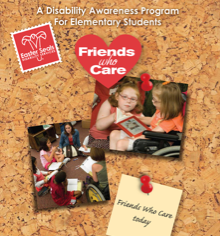What is self advocacy?
Developing self-knowledge is the first step in self advocacy skills. Learning about one’s self involves the identification of learning styles, strengths and weakness, interests, and preferences. For students with mild disabilities, developing an awareness of the accommodations they need will help them ask for necessary accommodations on a job and in post-secondary education. Students can also help identify alternative ways they can learn. Self advocacy refers to:
an individual’s ability to effectively communicate, convey, negotiate or assert his or her own interests, desires, needs, and rights. It involves making informed decisions and taking responsibility for those decisions.
Self-advocacy is not a new concept in disability services. Enabling and empowering students to direct their own lives has been an underpinning of federal legislation for some time. For example, the Workforce Investment Act of 1998, Title 1, Vocational Rehabilitation Program, describes the philosophy of independent living as including consumer control, peer support, self-help, self-determination, equal access, and individual and system advocacy, in order to maximize the leadership empowerment, independence, and productivity of persons with disabilities.

How can we improve self advocacy?
There are many components in developing self advocacy skills in young adults who are engaged in the transition process. Helping the student to identify future goals or desired outcomes in transition planning areas is a good place to begin. Self-awareness (self-knowledge) is critical for the student in determining the direction that transition planning will take.
These strategies to help individuals with disabilities develop self advocacy skills:
- Promote the student as a self-advocate
- Encourage the student to be active in the IEP process and other decision-making situations. Assist the student in compiling and developing an exit file. This file should include the last IEP, a transition plan, documentation of disability, recent test scores and assessment summaries, a list of strengths and areas of need, a list of home or work accommodations needed, a summary of learning style, letters of recommendation, and the telephone numbers of service providers. This file empowers the student and encourages self-knowledge. Self advocacy issues and lessons will be most effective if they are integrated daily.
- Respond to students who self-advocate appropriately
- Listen to the problem and ask the student for input on possible accommodations or modifications that he or she may need. Talk with the student about possible solutions, discussing the positive and negative sides. A person who self-advocates should not feel alone. Good self-advocates know how to ask questions and get help from other people. They do not let other people do everything for them or tell them what to do. Self-advocates are assertive. Assertive people tell others what they want and need, but they do not demand they respect the rights and feelings of other people. They talk over their ideas with other people. They ask questions for guidance, and then make up their own minds after reviewing the information. They may have strong feelings, but they try to be objective when making their decisions.
- Identify strategies for teaching self advocacy
- Students need opportunities to practice newly acquired self-advocacy skills.
- Students apply self advocacy skills by calling and requesting information about a service they need for transition from high school. Students can prepare to visit an adult service provider by compiling a list of questions to ask and requests for services.
- Identify examples of self-advocacy objectives on an IEP
Teachers may wish to have students’ role play various situations, in which they can practice skills such as the following:
- Setting up a class schedule
- Moving out of the home
- Asking for accommodations needed for a course
- Meeting with a rehabilitation counselor or social service caseworker
- Meeting with a medical provider
- Working with a personal care attendant
- Interviewing for a job
- Making choices in an IEP meeting
Following are some examples of objectives for an IEP that would promote development of self advocacy. Students will:
- State their rights as mandate under the Individuals with Disabilities Act Amendments of 1997, P.L. 105-17.
- State their rights as mandated under Title I of the Workforce Investment Act of 1998 (Vocational rehabilitation) and Americans with Disabilities Act (ADA).
- Be able to access information from the support service staff of the post secondary school in which they have expressed an interest
- State the type of information necessary to self advocate
- Define the terms assertive, passive, and aggressive
- Identify assertive, passive, and aggressive behavior in written scenarios
- State examples of their own assertive, passive, and aggressive behaviors
- Respond assertively in a given situation
Students need specific self advocacy skills for job interviews. Here are a few examples:
- Be prepared: Complete an application and a resume.
- Be alert: Greet interviewer, establish eye contact, and sit up straight.
- Be an interested listener: Show enthusiasm.
- Express yourself clearly: Avoid slang and negative comments.
- Tell about yourself: Describe your strengths, goals, and past experiences.
- Ask questions: Show interest and energy.
- Describe what you have to offer or the types of work you want to do: Demonstrate self-confidence and enthusiasm.
- These are just a few examples of the techniques educators and parents can use to ensure that students have the self-advocacy skills needed to make the transition from school to work. It is important that self-advocacy be recognized as a critical component of transition if the ultimate goal of transition-independence-is to be achieved.




